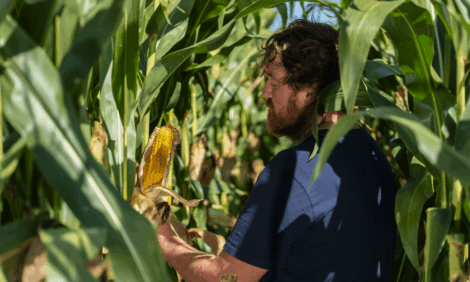



Natural Service versus Estrous Synchronization and AI
By Ryon S. Walker, Regional Extension Educator, University Of Minnesota Beef Team. This time of year producers are planning their summer breeding season schedules.
In the months prior to the breeding season, producers are fine tuning their herd bull management. Every year the question always sits in the back of most producers’ minds whether they should try using estrus synchronization and artificial insemination (AI) this year. However, the lack of change and a producer’s management goals usually persuade the use of natural service breeding over estrus synchronization and AI from year to year. The question remains, if goals such as length of a calving season, reproduction, growth or carcass performance are being achieved with natural service breeding, why change. Remember there are pros and cons to both natural service versus estrus synchronization and AI. Utilizing natural service requires management of factors affecting fertility of bulls such as nutrition, health, injury and age and having to purchase herd bull replacements of superior quality and genetics can become costly to a producer as well.
While most producers continually use traditional natural service breeding, reproductive biotechnology has been introduced over the years to assist producers in becoming more profitable in their management decisions. Artificial insemination was first used in the U.S. ( Minnesota) in the late 1930s with estrus synchronization receiving some popularity in the early 1960s. However, it’s amazing to note that a 1998 national survey indicated less than 12% of beef producers in the U.S. use any means of estrus synchronization and less than 14% use artificial insemination. This study represented 85% of all U.S. beef cows and 66.3% of all U.S. beef operations as of January 1, 1997. This survey (conducted by the National Animal Health Monitoring System) also indicated that time/labor, the technology not working, lack of facilities, cost and the technology too complicated were five reasons for producers not utilizing these technologies with time/labor being the number one reason among beef cattle producers. Natural service, no doubt, may be the easiest method of breeding cattle for producers that may not have the time and labor required to implement estrus synchronization and AI; however, several production goals can be implemented into a management system with quicker results utilizing these reproductive biotechnologies.
The benefits of using a breeding system that incorporates estrus synchronization and AI can be tremendous. These systems allow producers to reach certain production or economic goals quicker than natural service and can open the doors to value added markets as well. These benefits include:
- Shortening and concentrating the calving and breeding season
- Increasing the time needed for postpartum recovery in cows and first-calf heifers
- The ability to induce anestrous cows and prepubertal heifers to cycle
- Moving the breeding season to an earlier time of year
- Introducing new genetics into the herd
- Improving the uniformity of a calf crop (weight, color, disposition)
- Increasing calf performance and weaning weights with earlier birthdates
Estrus detection can be a time and labor consuming process, which makes artificial insemination programs impractical for some beef cattle producers. Estrus detection can be eliminated by breeding animals at a designated or pre-determined time, also known as timed-AI or mass mating. Estrus synchronization systems that incorporate timed-AI have advanced in their ability to control the estrous cycle and induce ovulation at a pre-determined time. Pregnancy rates to timed-AI have matched or exceeded pregnancy rates to AI and twice daily heat detection allowing producers the opportunity to incorporate these technologies without too much time and labor involved.
The use of estrus synchronization and AI has been advocated as a way to breed females in a shorter time period and improve the genetics of a cow herd and its progeny without the expense of buying superior bulls. Introducing specific lines of genetics provide openings for niche marketing and value added products. Opportunities for value added beef are increasing with demands from major retailers requesting source verification. Age verification from AI calves may become a requirement for the eligibility of beef products for overseas markets. Estrus synchronization, along with artificial insemination, can be a valuable tool for smaller operations where the number of cattle (1-25 head) may not justify the cost for purchasing a bull of superior quality and genetics. Synchronization programs are also available to be used for natural service breeding to concentrate the calving season further without the use of AI. There is a new user-friendly Excel software program (Estrus Synch Planner) available that allows producers to customize their breeding season to best fit his/her operation utilizing 22 estrus synchronization protocols and three different methods of AI.
Today, estrus synchronization and AI remain to be the most available and widely applicable reproductive biotechnology available to beef producers. However, the low adoption rates of these reproductive technologies question the direction of the beef cattle industry in the U.S. and competitive intuition among beef producers. The United States and Brazil are world leaders in total number of beef cows in production; yet, beef producers in Brazil are inseminating 3.5 times more cows annually than U.S. beef producers. Unless beef cattle producers in the U.S. become more aggressive in their approach to reproductive management and genetic improvement, the competitiveness for supplying high-quality beef with other countries will increase.
March 2007



